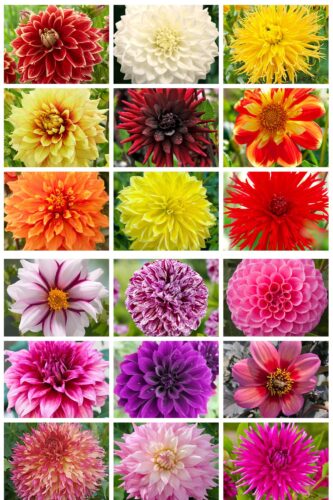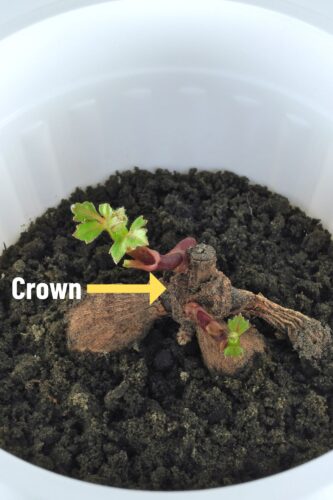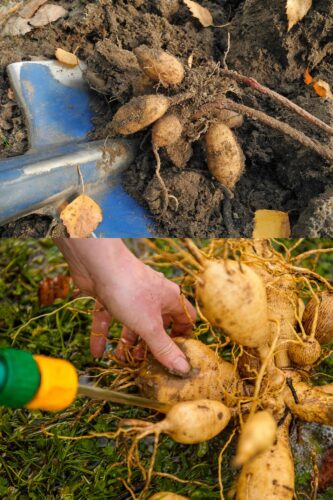Dahlias are a true wonder to behold in the summer garden. They are known for their vibrant colors and tightly packed, often large, flower heads. In this article, we’ll review the advantages of using these beauties in your garden plus tips on planting dahlias, growing dahlias, and dahlia aftercare advice.
Dahlia Details: Classification, Planting, Growing and Storage Tips
Classification
 Dahlias come in a wide range of shapes, sizes, and colors. The two largest classifications of dahlias refer to the petal arrangement. These classifications are single-flowering and double-flowering. The terms single or double flowering do not refer to how many times the plant will bloom but rather to the bloom structure itself. The single-flowering varieties bloom with just a single row of petals where as the double-flowering will have multiple rows. In addition to the flower structure, the plant growth and flower size are also distinguished between single and double-flowering dahlias. Single flowering dahlias typically grow less than 3′ in height and blooms tend to be less than 4″ in diameter. Double-flowering dahlias typically grow in excess of 3′ in height and form larger blooms.
Dahlias come in a wide range of shapes, sizes, and colors. The two largest classifications of dahlias refer to the petal arrangement. These classifications are single-flowering and double-flowering. The terms single or double flowering do not refer to how many times the plant will bloom but rather to the bloom structure itself. The single-flowering varieties bloom with just a single row of petals where as the double-flowering will have multiple rows. In addition to the flower structure, the plant growth and flower size are also distinguished between single and double-flowering dahlias. Single flowering dahlias typically grow less than 3′ in height and blooms tend to be less than 4″ in diameter. Double-flowering dahlias typically grow in excess of 3′ in height and form larger blooms.
The single-flowering dahlias include the Impression, Single, Orchid-Flowering, and Collarett varieties and tend to be less prominent. The double-flowering dahlias consist of the Cactus, Semi-Cactus, Decorative, Dinnerplate, Ball or Pompon, Border, and Novelty varieties.
Planting Dahlias
 When purchased as bulbs, Dahlias are sold as tubers. These tubers often resemble a disfigured hand with multiple “fingers” extending downward from the center. The center of the tuber is actually the crown of the stem from the previous year’s growth. When dahlias sprout after planting, a small green shoot protrudes from this center crown. Dahlias require well-drained soil and do not tolerate wet soil. To improve soil drainage, a good mixture of organic material, including peat moss and compost manure, does wonders when mixed with little clay content. Again, like most bulbs, the Dahlia tubers will rot if allowed to sit wet for long periods.
When purchased as bulbs, Dahlias are sold as tubers. These tubers often resemble a disfigured hand with multiple “fingers” extending downward from the center. The center of the tuber is actually the crown of the stem from the previous year’s growth. When dahlias sprout after planting, a small green shoot protrudes from this center crown. Dahlias require well-drained soil and do not tolerate wet soil. To improve soil drainage, a good mixture of organic material, including peat moss and compost manure, does wonders when mixed with little clay content. Again, like most bulbs, the Dahlia tubers will rot if allowed to sit wet for long periods.
Select a sunny location the area should receive at least 6 hours of sunlight per day. Protection from strong winds is another consideration when selecting a site for dahlia planting. The tubers should be planted “fingers down” in the soil, with the center of the tuber where the crown is just at the soil surface. Depending on the size of the tuber and the specific dahlia variety, spacing should typically range from 18 to 36″ apart, leaving them enough room to spread and grow properly.
Growing Dahlias
Plant dahlias in spring or early summer. They can be planted anytime after the threat of frost is gone but before the weather gets too warm. For most of the United States, this period falls between mid-March and June. Dahlias will begin blooming mid-summer, and most will continue on in the late summer and sometimes early fall. Keep the soil moist but not saturated during the summer months.
Pruning Dahlias
Once the plants reach a foot or so in height, the terminal shoot (or center stem) of the plant should be pinched back to encourage branching. For increased flower size, pinch back the lateral (side) flower buds to direct more energy and nutrients to the main flower bud at the end of the stem.
Fertilizing Dahlias
To get the most floriferous dahlias, fertilization is key. Dahlias are heavy feeders and benefit from added nutrients during the growing season. Fertilize once a month during the growing season with a water-soluble bloom-boosting fertilizer such as Jack’s Bloom Booster Fertilizer.
Tuber Storage
 Once the plants have completed their growing and blooming cycle, the leaves and flower stems begin to die back as they enter their dormant stage. Dahlias are hardy in Zones 8, 9, 10, and 11. In these areas, simply cut the stems back to within 1-4″ of the soil surface once they have completely died back. Leave the tuber in the ground for the remaining fall and winter.
Once the plants have completed their growing and blooming cycle, the leaves and flower stems begin to die back as they enter their dormant stage. Dahlias are hardy in Zones 8, 9, 10, and 11. In these areas, simply cut the stems back to within 1-4″ of the soil surface once they have completely died back. Leave the tuber in the ground for the remaining fall and winter.
If located in Zones 1-7 take special care of the tubers to protect them from harsh winter weather and temperatures. Southern parts of Zone 7 can usually get away with giving the tubers a good drink of water in the fall and placing a thick layer of mulch over the area where the tubers are planted. However, to be safe it is best to remove the tubers from the soil and overwinter indoors.
How to Store Dahlia Tubers
- After the first frost, cut back the foliage and stems to within 1-4″ of the soil surface.
- Carefully dig out the dahlia tuber, being sure not to sever any of the “fingers”. To avoid damaging the tuber, begin by digging at least 12″ away from the center of the plant in all directions.
- Gently brush off any excess dirt from the tubers and spread them out in a shaded, well-ventilated area for several days. Do NOT leave the tubers in full sun.
- Pack the tubers upside down in a well-ventilated box, basket, or bag using slightly damp vermiculite, perlite, or peat moss, covering the clumps of tubers.
- Store in temperatures of 35°F to 50°F and protect from hot or cold drafts.
- Replant in the spring once the ground has thawed.
We have more helpful tips on storing dahlias overwinter here in this article.
Dreaming of Dahlias All Day Long
One of the longest summer-blooming bulbs, the variety and vibrant colors of Dahlias are something you won’t want to leave out of your summer garden this year. Experienced gardeners as well as beginner gardens will love the low-fuss results in summer they will receive when planting dahlias this spring. Dahlias impress when outdoors in the garden, in a sunny border, and especially when front and center in a vase on your kitchen table. Grow dahlias this summer; the big and bold blooms will wow your neighbors!
Learn More About Planting Dahlias With These Helpful Articles:
Dainty Dahlias: Border Dahlias, Ball Dahlias and Pompon Dahlias


